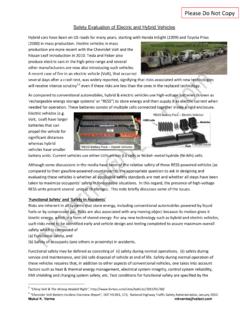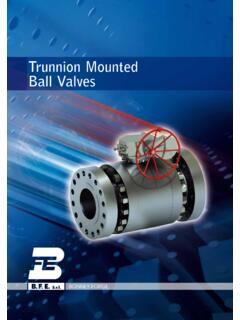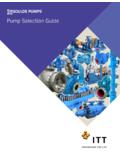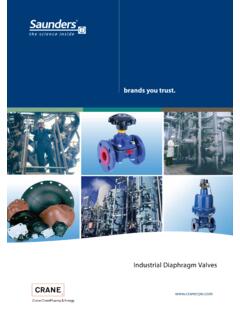Transcription of CHAPTER 21 Mechanical Design of Mixing Equipment
1 CHAPTER 21. Mechanical Design of Mixing Equipment D. S. DICKEY. MixTech, Inc. J. B. FASANO. Chemineer, Inc. 21-1 INTRODUCTION. Mixing Equipment must be designed for Mechanical and process operation. Al- though mixer Design begins with a focus on process requirements, the Mechanical Design is essential for successful operation. Usually, a competent manufacturer of Mixing Equipment will take responsibility for the Mechanical Design . However, process conditions, such as impeller operation near a liquid surface, can impose severe Mechanical loads. Similarly, the process environment will influence the selection of a motor enclosure. In many ways the process requirements can have a direct impact on the Mechanical Design . In other ways, such as the natural frequency of a mixer shaft, appropriate Mechanical Design must be determined by the Equipment designer.
2 Whatever the reason, knowledge of the Mechanical requirements for a mixer will help guide the engineer toward a Design that will meet both process and Mechanical criteria. The purpose of this CHAPTER is to provide practical information about the Mechanical Design of Mixing Equipment . Therefore, descriptions, equations, and nomenclature will be given in both engineering units and metric units. Descriptions and equations using engineering units will follow common industrial practices used in the United States with Design information for mate- rials measured in inches and motors specified in horsepower. Descriptions using Handbook of Industrial Mixing : Science and Practice, Edited by Edward L. Paul, Victor A. Atiemo-Obeng, and Suzanne M.
3 Kresta ISBN 0-471-26919-0 Copyright 2004 John Wiley & Sons, Inc. 1247. 1248 Mechanical Design OF Mixing Equipment . metric units will reference materials commonly measured in millimeters (mm), while equations will do calculations in meters (m). Metric units in equations will follow SI metric practice. To avoid confusion, values in the text that are also used in equations will use standard SI units even if more reasonable numeric values are possible with prefixes. Units for variables in engineering units ( Eng.) are shown in brackets []. Units for variables in metric units (Metric) will be shown in braces {}. The nomenclature list shows both engineering units and metric units used in the equations. Care must be taken to use the correct units, since several equations contain dimensional constants.
4 Results can be incorrect if the wrong units are used. 21-2 Mechanical FEATURES AND COMPONENTS OF MIXERS. Because of the diversity of fluid Mixing applications and variety of vessels, many different styles of mixers are used in industrial applications. Mixer sizes include small fractional-horsepower portable mixers to huge 1000 hp plus mixers. Although normally viewed as a single piece of Equipment , like a pump, the typical mixer is composed of several individual components, such as a motor, gear reducer, seal, shaft, impellers, and tank, which is often designed and purchased separately. Although highly customized for many applications, most mixers are a combination of standard components, sometimes with modifications, and often with unique characteristics, such as shaft length.
5 Generalizations, especially for mixers, can misrepresent individual situations, but some features are common to the largest number of mixers built worldwide. The most common motive force for a mixer is an electric motor, so a knowledge of standard motor characteristics is useful. Most mixers operate at or below typ- ical motor speeds, so some type of speed reduction is common. Speed reduction can be accomplished with several different types of gears, usually in enclosed housings, or with belts and sheaves. Besides speed reduction, antifriction bear- ings are found in all types of rotating Equipment . Some type of seal around the rotating shaft is required for closed-tank operation and the type depends on degree of seal required, operating pressure, and operating temperature.
6 The shaft for a mixer, especially a large one, involves significant Mechanical Design , partly because of the myriad of shaft lengths, impeller sizes, and operating speeds, and partly because both strength and rigidity are necessary for a successful Design . The combination of custom process and Mechanical Design necessary for mixers is unique for chemical process Equipment . Mechanical Design does not end with the shaft, since strength and practical issues remain for the impeller. Another part of mixer Design is the tank in which the mixer is used, since tank dimensions influence mixer features, especially shaft length. Conversely, a mixer requires tank features, such as baffles, support strength, and other tank internals. Materials of construction, although most commonly metal alloys for mixers, depend on process chemistry and operational requirements.
7 Other Mechanical features can be important in special-purpose mixers, such as high-shear mixers, dry-solids mixers, and static mixers. Without revealing trade Mechanical FEATURES AND COMPONENTS OF MIXERS 1249. secrets or emphasizing proprietary technology, elements of the same Mechanical Design considerations apply to special-purpose mixers. The primary Mechanical emphasis in this CHAPTER is on Equipment discussed elsewhere in this book. Each key element of the Mechanical characteristics of mixers will be covered in this section. Although not comprehensive with respect to each topic, the equip- ment and Design requirements discussed should cover most of the mixer types and applications. Even with the diversity of Mixing Equipment , features such as motors and materials of construction are Mechanical considerations, common to all types of mixers.
8 Impeller-Type Mixing Equipment Impeller-type Mixing Equipment represents the largest category of general purpose Mixing Equipment for fluid processing applications. From the process view of impeller-type Equipment , an impeller, usually composed of blades mounted to a central hub and rotated by a drive shaft, pushes and moves the material to be mixed. The Mixing action and the process results are primarily a result of this material, usually fluid, motion. The Mechanical Design of impeller-type Mixing Equipment is responsible for the process by which some form of energy, such as electricity, is converted into fluid motion. That fluid motion is ultimately dissipated as heat, hopefully after the process objectives are accomplished. To present an organized understanding of Mixing Equipment , some common terminology is used to describe typical characteristics.
9 Each category of equip- ment has some loosely defined limits, often with overlap to other categories, depending on features provided by different manufacturers of the Equipment . Portable Mixers. Portable mixers may or may not be truly por- table, depending on size and mounting. However, the term portable mixer most often refers to mixers with 14 hp to 3 hp drives mounted with either a clamp or a bolted-swivel mount. Smaller mixers are usually considered laboratory or pilot-plant Equipment and are not often used in industrial production processes. Most portable mixers operate at either motor speed, such as 1800 rpm (30 rps). or 1200 rpm (20 rps) with 60 Hz power, or with a single-reduction gear drive (approximately a 5 : 1 speed reduction) for 350 rpm ( rps).
10 Although details of impeller types vary, axial flow impellers, such as marine propellers or three- blade hydrofoil impellers, are used most often. A typical direct-drive portable mixer is shown in Figure 21-1 and a gear drive portable in Figure 21-2. Top-Entering Mixers. The designation top-entering mixers has become accepted as a more restrictive term than the name would imply. Top- entering mixers are usually considered the equivalent of portable mixers with flange mountings, or perhaps larger mixers but with light-duty gear drives and motors less than 10 hp (7460 W). This designation is less of a true definition than an accepted industry practice used to describe basic mixer products. By this definition, top-entering mixers have flange or pedestal mounts, com- pared with the clamp or swivel-plate mounts used on portables.









